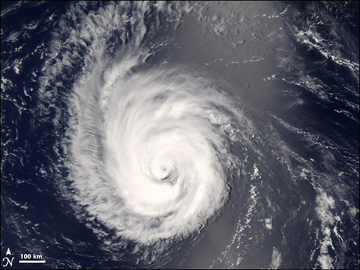Hurricane Bertha never got close to the United States, but it was a killer nonetheless. The storm meandered around the North Atlantic in July of 2008. It stayed hundreds of miles off the U.S. coast. Even so, it killed three swimmers in New Jersey, and required more than 1500 beach rescues in Maryland – not because of high winds or a massive storm surge, but by creating powerful rip currents.
 Satellite image of Hurricane Bertha in 2008. Credit: NASA
Satellite image of Hurricane Bertha in 2008. Credit: NASAA rip current forms as water pushed ashore by wind and waves moves back out to sea. It moves through gaps in sandbars that concentrate the flow into narrow, swift channels that can carry unsuspecting swimmers out to sea. In fact, rip currents cause about a hundred deaths on American beaches each year.
The currents are especially deadly when there’s an approaching storm. Even one that’s far away can create strong waves that crash along the shoreline. The waves can change the contours of the ocean floor just off the beach.
The waves also push water toward the shore more forcefully, so the return flow – the rip current – is stronger than normal. Storm-driven currents can reach speeds of five miles per hour. Surfers often use the rip currents to speed out to sea where they can catch the large waves. But such currents are stronger than most swimmers can overcome.
So during hurricane season, experts urge swimmers to be especially cautious on the beaches. Know where the rip currents are and how to escape them. And keep an eye on the weather forecast – for distant but potentially deadly storms.
This episode of Science and the Sea was made possible by Texas Sea Grant.

